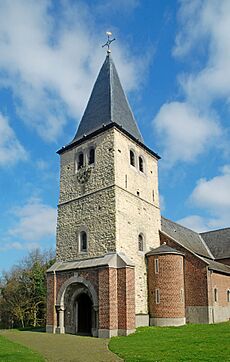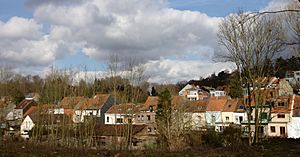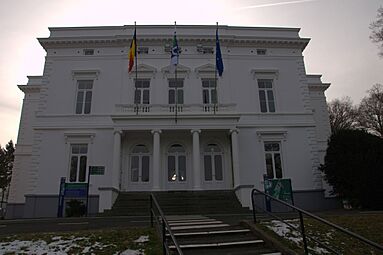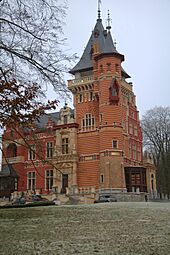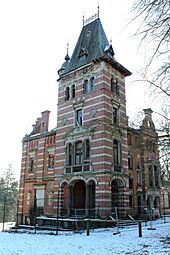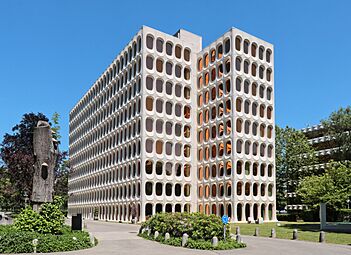Watermael-Boitsfort facts for kids
Quick facts for kids
Watermael-Boitsfort
|
|||
|---|---|---|---|
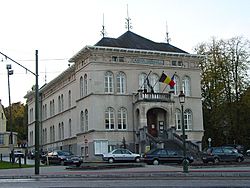
Watermael-Boitsfort's Municipal Hall, built in 1845
|
|||
|
|||
| Country | Belgium | ||
| Community | Flemish Community French Community |
||
| Region | Brussels | ||
| Arrondissement | Brussels-Capital | ||
| Area | |||
| • Total | 12.93 km2 (4.99 sq mi) | ||
| Population
(2018-01-01)Lua error in Module:Wd at line 1575: attempt to index field 'wikibase' (a nil value).
|
|||
| • Total | Lua error in Module:Wd at line 1,575: attempt to index field 'wikibase' (a nil value). | ||
| Postal codes |
1170
|
||
| Area codes | 02 | ||
| Website | www.watermael-boitsfort.be www.watermaal-bosvoorde.be |
||
Watermael-Boitsfort (pronounced "wah-ter-mal bwah-for" in French) or Watermaal-Bosvoorde (pronounced "wah-ter-mal boss-for-duh" in Dutch) is one of the 19 towns that make up the Brussels-Capital Region in Belgium. People often call it just Boitsfort in French or Bosvoorde in Dutch.
This town is located in the southeastern part of the Brussels area. It shares borders with other towns like Auderghem, Ixelles, and Uccle. It also touches the Sonian Forest and some towns in the Flanders region. Like all towns in Brussels, Watermael-Boitsfort is officially bilingual, meaning both French and Dutch are spoken.
As of January 1, 2022, about 25,187 people lived here. The town covers an area of about 12.97 square kilometers (5 square miles). A large part of it, about 58%, is covered by the beautiful Sonian Forest. This means it has fewer people living per square kilometer compared to other parts of Brussels. Watermael-Boitsfort is also known for having one of the highest average incomes per person in the Brussels region.
Contents
History of Watermael-Boitsfort
Watermael-Boitsfort started as two separate small villages. These villages were located on a flat area between two small rivers, the Woluwe and the Watermaelbeek. They were just north of the large Sonian Forest.
Scientists have found signs of human life here from a very long time ago. They discovered remains of a small fortified village from the Stone Age, specifically between 3500 and 2500 BC.
The name Watermael was first written down in a document from 914 AD. It was about a piece of land given to a French monastery (a place where monks live). The name might come from old words meaning "water" and "a dip in the land."
Later, in the 13th century, Boitsfort became a separate area. This happened when a hunting lodge near the forest was given to the Boutsvoord family by the Duchy of Brabant (an old kingdom). During the Middle Ages, people in both villages mostly farmed and raised animals. Many hunting lodges were built for rich nobles who wanted to hunt in the forest.
A new road was built to the city of Brussels, which helped both villages grow quickly. For example, the number of people in Watermael grew from 349 in 1709 to 826 in 1800.
The two villages, Watermael and Boitsfort, officially joined together in 1811. This happened when France ruled the area. Even though some factories started in the 1800s, Watermael-Boitsfort mostly stayed a farming area. It also became a popular place for people to live, especially after a railway line connected it to Brussels in 1854. Soon, it became a trendy, wealthy neighborhood.
At first, Dutch was the main language spoken here. But after 1920, French became more common. In the 1920s, two special neighborhoods called "garden cities" were built: Le Logis and Floréal. These were designed to have lots of green spaces. The town's population reached its highest point in 1970, with 25,138 people.
One of the first mayors of Watermael-Boitsfort was Pierre-Théodore Verhaegen. He was important for helping create the Free University of Brussels. He was mayor from 1825 to 1842.
About the People and Money
Watermael-Boitsfort is known as one of the wealthiest towns in Brussels. In 2002, the average income per person was €30,100. This was higher than the average for the whole Brussels area. Also, a smaller percentage of its residents were not Belgian citizens compared to the Brussels average.
Since 2000, the local government has been led by a mix of political parties. These include the liberal Mouvement Réformateur, the regionalist DéFI, and the green Ecolo parties. The current mayor, also called a bourgmestre, is Olivier Deleuze from the Ecolo party.
There are two train stations in the town: Watermael railway station and Boitsfort railway station. Both are on the same train line.
The International School of Brussels (ISB) is also located in Watermael-Boitsfort. This school was founded in 1951.
Cool Buildings to See
Watermael-Boitsfort has many interesting old buildings. One of the most notable is the Church of St. Clement. Parts of this church are very old, dating back to the 11th century.
The town also has many grand old country houses, which used to belong to wealthy families. Some of these include:
- Chateau Tournay-Solvay, which was once the home of Alfred Solvay.
- Château de Jolimont, where the painter Jacques d'Arthois lived.
- Château Bischoffsheim, which now houses the International School of Brussels.
- Château Charle-Albert, which was the home of former Belgian Prime Minister Paul van Zeeland.
- Château Morel.
- Château des Fougères, which is now part of a fancy apartment complex.
Sports and Fun
Watermael-Boitsfort is home to some successful sports teams. The Boitsfort Rugby Club is one of Belgium's best rugby teams. There's also a football (soccer) team called Royal Racing Club de Boitsfort.
The Boitsfort Hippodrome was once a horse-racing track, built in 1875. It's not used for horse racing anymore. Since 1987, the middle of the track has been a golf course for the Brussels Golf Club. The old horse racing track is now a popular place for people to run, bike, and walk their dogs. It's often the start and finish line for local 10-kilometer races.
In 2016, the park, now called DROHME, got some big updates. The old spectator stands and the jockey-weighing station were renovated. In September 2018, the weighing station reopened as a restaurant.
Famous People from Watermael-Boitsfort
Many interesting people have lived in Watermael-Boitsfort, including:
- Auguste Beernaert (1829–1912): A politician who won the Nobel Peace Prize and was once the Prime Minister of Belgium.
- Omer Coppens (1864–1926): An artist known for his impressionist paintings.
- Willy Coppens (1892–1986): A famous pilot (flying ace) from World War I.
- Paul Delvaux (1897–1994): A well-known artist. He painted the Watermael train station many times.
- Georges Remi, also known as Hergé (1907–1983): The famous writer and artist who created the popular comic series The Adventures of Tintin.
- Rik Wouters (1882–1916): An artist and sculptor.
Friends Around the World (Twin Towns)
Watermael-Boitsfort has special friendships with other towns around the world. These are called "twin towns" or "sister cities."
 Chantilly, France
Chantilly, France Annan, United Kingdom
Annan, United Kingdom Hegyvidék, Hungary
Hegyvidék, Hungary
See also
 In Spanish: Watermael-Boitsfort para niños
In Spanish: Watermael-Boitsfort para niños





